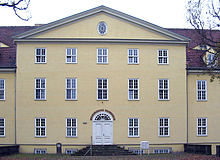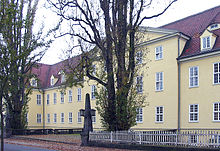Gröba electricity association administration building
The former Niederlößnitz administration building of the Gröba Electricity Association is located in the Niederlößnitz district of the Saxon city of Radebeul , in Körnerweg 5. It replaced the original administration building on the manor Gröba . Today a senior citizens' residence is housed on the Radebeul property .
description
The wide, now a listed building of the “type of a baroque castle” stands along the slope and at the eaves facing the Körnerweg. The two-storey building above a partially high basement has a moderately developed saddle-top floor with slim gable dormers and bat dormers attached above. In the street view, there is a three-storey central projection with a flat triangular gable above it, at the ends of the building there are side wings with a hipped roof . The sparse plastered building has a natural stone base and a tiled roof. The slender windows show cross -section and muntin division .
A flight of stairs and a terrace with balustrades lead to the main entrance in the central risalit. On the terrace are two sandstone obelisks with lights. The fence fields of the wooden fence have convex arches at the top. Inside the building there is a two-story entrance hall with a baroque staircase.
Behind the former administration building there is an elongated garage with a steep gable roof with bat dormers and arched gates. At the ends there are short wing structures with high triangular gables.
history
Electricity Association Gröba
On December 29, 1909, the founding meeting of the municipal association of the authorities in Grossenhain and Meißen (both in Dresden ) and Oschatz (in Leipzig ) took place. In 1910 the Amtshauptmannschaft Döbeln (District Headquarters Leipzig) joined. The association's administrative headquarters were on the manor Gröba near Riesa , the administrative building there was designed by the Dresden architect Martin Hammitzsch . In June 1910, the Saxon Ministry of the Interior approved the association's statutes with the condition that an expert be appointed to build the utility company. Thereupon the electrical engineer Wilhelm Kübler was commissioned with the conception by the Technical University of Dresden . The construction of our own power plant was temporarily postponed in negotiations with the Lauchhammerwerke. Instead, an electricity supply contract was signed with Lauchhammerwerke for a term of 40 years. The first 100,000 volt line in Europe was installed for this delivery. It ran over 55 km from the Lauchhammer power station via Gröditz to Gröba and was the property of the Lauchhammer works. The Gröba Electricity Association (EV Gröba) then built a 60 kV ring line from Gröba via Schweta , Naundorf near Leisnig, Etzdorf , Deutschebora , Strießen near Großenhain to Gröditz with a total length of approx. 120 km. In the substations, transformers converted the voltage from 60 kV to 15 kV.
In 1920 the community association Elektrizitätswerk Niederlößnitz joined with its electricity works in Lößnitzgrund, which had already joined the special purpose association "Vorortammelschiene" in the same year . The area supplied increased by the area of the association, and the electrical connection of the Loessnitzbahn was added.
The Groeba Electricity Association built a new administration building in Niederlößnitz in 1924, and the Gröba settlement was also built to accommodate employees.
By 1926, the area served expanded to include the communities of Boxdorf , Coswig , Dippelsdorf - Buchholz , Eisenberg - Moritzburg , Kötitz , Reichenberg , Wahnsdorf and Wilschdorf . In 1928 the Etzdorf substation fell asleep in the nearby 100 kV Dresden-Hirschfelde line. For this purpose, a 100 kV system was installed outdoors for the first time. In 1928/29 the substation No. 11 was built at Meißner Straße 177, in front of which two civil servants' houses were built in addition to the residential buildings on Rosa-Luxemburg-Platz .
During the GDR era, the electricity association became part of the VEB Energiekombinat Ost .
Administration building
In 1924, the Gröba Electricity Association applied for the construction of a new administration building, the design of which came from the architect Otto Rometsch . Six fluted pilasters and a flight of stairs over the entire width of the central risalite were not made from this design . The building was completed in 1925, and on December 1, 1925, approval was given for the elevator to go into operation.
The garage was built in 1929. In 1934 the high turret with dome burned down and was not replaced. The company archive was also destroyed in this fire.
After the Second World War, the building became the seat of the Soviet command, later the seat of VEB Energiebau . After several years of vacancy after reunification and extensive renovation, a senior citizens' residence opened there in 2001.
literature
- Frank Andert (Red.): Radebeul City Lexicon . Historical manual for the Loessnitz . Published by the Radebeul City Archives. 2nd, slightly changed edition. City archive, Radebeul 2006, ISBN 3-938460-05-9 .
- Volker Helas (arrangement): City of Radebeul . Ed .: State Office for Monument Preservation Saxony, Large District Town Radebeul (= Monument Topography Federal Republic of Germany . Monuments in Saxony ). SAX-Verlag, Beucha 2007, ISBN 978-3-86729-004-3 .
Web links
Individual evidence
- ^ Large district town of Radebeul (ed.): Directory of the cultural monuments of the town of Radebeul . Radebeul May 24, 2012, p. 22 (Last list of monuments published by the city of Radebeul. The Lower Monument Protection Authority, which has been based in the Meißen district since 2012, has not yet published a list of monuments for Radebeul.).
- ↑ Volker Helas (arrangement): City of Radebeul . Ed .: State Office for Monument Preservation Saxony, Large District Town Radebeul (= Monument Topography Federal Republic of Germany . Monuments in Saxony ). SAX-Verlag, Beucha 2007, ISBN 978-3-86729-004-3 , p. 177 .
Coordinates: 51 ° 6 ′ 25 ″ N , 13 ° 39 ′ 22 ″ E




